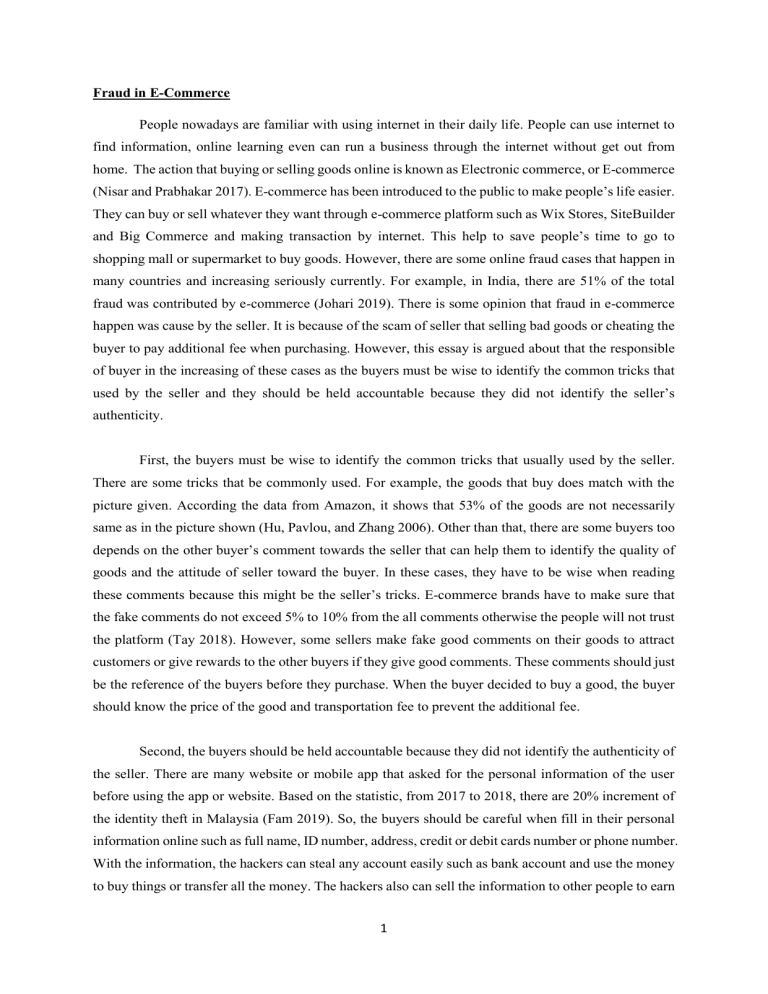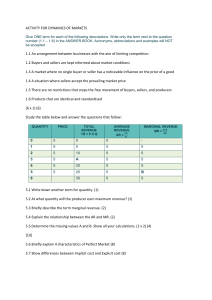
Fraud in E-Commerce People nowadays are familiar with using internet in their daily life. People can use internet to find information, online learning even can run a business through the internet without get out from home. The action that buying or selling goods online is known as Electronic commerce, or E-commerce (Nisar and Prabhakar 2017). E-commerce has been introduced to the public to make people’s life easier. They can buy or sell whatever they want through e-commerce platform such as Wix Stores, SiteBuilder and Big Commerce and making transaction by internet. This help to save people’s time to go to shopping mall or supermarket to buy goods. However, there are some online fraud cases that happen in many countries and increasing seriously currently. For example, in India, there are 51% of the total fraud was contributed by e-commerce (Johari 2019). There is some opinion that fraud in e-commerce happen was cause by the seller. It is because of the scam of seller that selling bad goods or cheating the buyer to pay additional fee when purchasing. However, this essay is argued about that the responsible of buyer in the increasing of these cases as the buyers must be wise to identify the common tricks that used by the seller and they should be held accountable because they did not identify the seller’s authenticity. First, the buyers must be wise to identify the common tricks that usually used by the seller. There are some tricks that be commonly used. For example, the goods that buy does match with the picture given. According the data from Amazon, it shows that 53% of the goods are not necessarily same as in the picture shown (Hu, Pavlou, and Zhang 2006). Other than that, there are some buyers too depends on the other buyer’s comment towards the seller that can help them to identify the quality of goods and the attitude of seller toward the buyer. In these cases, they have to be wise when reading these comments because this might be the seller’s tricks. E-commerce brands have to make sure that the fake comments do not exceed 5% to 10% from the all comments otherwise the people will not trust the platform (Tay 2018). However, some sellers make fake good comments on their goods to attract customers or give rewards to the other buyers if they give good comments. These comments should just be the reference of the buyers before they purchase. When the buyer decided to buy a good, the buyer should know the price of the good and transportation fee to prevent the additional fee. Second, the buyers should be held accountable because they did not identify the authenticity of the seller. There are many website or mobile app that asked for the personal information of the user before using the app or website. Based on the statistic, from 2017 to 2018, there are 20% increment of the identity theft in Malaysia (Fam 2019). So, the buyers should be careful when fill in their personal information online such as full name, ID number, address, credit or debit cards number or phone number. With the information, the hackers can steal any account easily such as bank account and use the money to buy things or transfer all the money. The hackers also can sell the information to other people to earn 1 profit. There had an issue of hackers steal 1.5 million people’s personal data by hacking the Singapore government’s health database that happen in 2018 (Baynes 2018). In addition, some hackers will send an email to tricks the buyers to get their username and password and overtake the account as theirs’ account. Then, they will log into the account and change the password and do purchase. Other than the buyers, the seller have the responsible to the increasing of fraud in e-commerce because some sellers are dishonest when run an online business with other people. The online fraud that common complaint by the customers are they does not receive the goods, the goods are not the same as advertised, receiving wrong goods or damage goods (“E-commerce fraud“ 2019). In this case, seller should make sure the content of the goods is correct and the goods have good quality before delivery it to the buyer. The e-commerce fraud happens when some sellers dishonest when doing transaction with the buyer. There are some sellers told the buyer the wrong price that include the seller’s own profit. Based on the survey, over 20% of buyers who experienced fraud in credit or debit card because of the seller that approved the fraudulent transaction (Chandler 2019). In conclusion, the buyers are responsible for the increase in e-commerce scams than the seller as they should be wise to identify the common tricks that used by the seller and they should be held accountable because they did not identify the seller’s authenticity. There are some ways to prevent the increasing in e-commerce fraud. The buyer should change the password of account or email often to avoid the hackers from hacking the account. For every account should not have the same password. The password should have a mix of letters, symbols or digits and not the buyer’s personal information that can get easily such as name or birthday date. This can prevent from the hackers to overtake the buyer’s account. In addition, the sellers should learn how to promote the products and the products that advertised should be the same with the real products. The buyers and the sellers should take their responsible to prevent the increasing in e-commerce fraud so that the people can run a business and enjoy their online shopping. Reference List 2 Baynes, Chris. 2018. “Hackers Steal 1.5 million People’s Personal Data in Cyber Attack on Singapore’s Health Service.” Independent. July 20,2018. https://www.independent.co.uk/news/world/asia/singapore-personal-data-hack-health-databasegovernment-millions-people-a8456111.html Chandler, Adam. “Decoding the Changing E-commerce Market in 2019: Inside Riskified’s Shopping and Fraud Behavior Report.” Riskified Blog, January 30, 2019. https://www.riskified.com/blog/inside-riskifieds-shopping-and-fraud-behavior-report/ “E-commerce Fraud Complaints on the Rise, Says Ministry.” 2019. Bernama. August 15, 2019.https://www.theedgemarkets.com/article/ecommerce-fraud-complaints-rise-says-ministry0 Fam, Christopher. 2019. “CSM: Identity Theft Increasing in Malaysia Mainly Due to Numerous Data Breaches.” The Star Online. April 16,2019. https://www.thestar.com.my/tech/tech- news/2019/04/16/ram-credit-information-to-work-with-cybersecurity-malaysia-to-preventidentity-theft Hu, Nan, Paul A Pavlou, and Jennifer Zhang. 2006. “Can Online Reviews Reveal a Product’s True Quality?: Empirical Findings and Analytical Modeling of Online Word-of-mouth Communication.” Paper presented at 7th ACM Conference on Electronic Commerce, Ann Arbor, Michigan, USA, June 11-15, 2006. https://dl.acm.org/citation.cfm?id=1134743 Johari, Sneha. 2019. “51% of Ad Fraud Came Through E-commerce in 2018: TeachARC Digital Report.” Medianama. March 18,2019. https://www.medianama.com/2019/03/223-techarc-adfraud-digital-report-2018/ Nisar,Tahir, and Guru Prabhakar. 2017. “What Factors Determine E-satisfaction and Consumer Spending in E-commerce Retailing?.” Journal of Retailing and Consumer Services. 39. 135-144. https://www.sciencedirect.com/science/article/pii/S0969698917302680 Tay, Vivienne. 2018. “Fake online reviews on the Rise: A Marketing Strategy for Online Retailers?.” Marketing Interactive. June 21, 2018. https://www.marketing-interactive.com/fake-onlinereviews-on-the-rise-a-marketing-strategy-for-online-retailers/ 3






